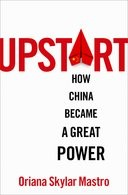
作者/Author(s): Oriana Skylar Mastro
網站來源/Source: Oxford University Press
日期/Date: 2024
關鍵字/Keywords: 強權、戰略、中國
摘要:
中國的崛起在某些方面與美國相似,但也有部分不同。Upstart分析了中國成為大國的戰略,以及中國在什麼情況下會跟隨或不跟隨美國的戰略。Mastro假設中國會在適合的情況下模仿美國的策略,而在不適合的情況下追求剝削或創業。中國的三E戰略(模仿、利用和創新)可以從外交、經濟和軍事方面觀察到。
三E戰略
三E戰略
- 中國的新興戰略有三個組成部分,可由競爭領域(舊領域或新領域)和方式(模仿或創新)來區分:
- 模仿: 舊領域,模仿。
- 利用: 新領域,模仿方式。
- 創業: 舊領域與新領域皆採用,創新方式。
- 一個崛起中的強國會考慮以下因素,模仿現有強國的策略:
- 對現有強國的看法
- 戰略的效率
- 戰略的有效性
- 國內政治
- 可利用的漏洞、盲點或弱點
- 中國會選擇模仿的情況
- 美國的戰略有效,且沒有可利用的空隙,而中國享有競爭優勢時(無論美國是否將中國視為威脅)。
- 中國會選擇利用的情況
- 當美國策略有效,但存在可剝削的漏洞且中國享有競爭優勢時(無論美國是否將中國視為威脅)。
- 中國的創新
- 美國的策略破壞了中共的控制。
- 美國策略無效。
- 美國策略有效,而中國缺乏競爭優勢且預期美國認為中國具有威脅性。
美國的啟示
- 有選擇性地模仿中國的戰略,如果不相容就不要模仿。
- 如果中國的模仿策略有利於美國,應鼓勵中國繼續模仿。
- 找出並修補美國戰略弱點或差距。
- 試驗新的戰略方法(創新策略)。
Summary:
China's ascension resembles the U.S. in some aspects but differs in others. Upstart analyzes China's strategies for becoming a great power and the conditions where it follows the U.S strategies or not. Mastro assumes China will imitate the U.S. strategy if suitable and pursue exploitation or entrepreneurship if incompatible. China's three E's (emulation, exploitation, and entrepreneurship) could be observed in diplomacy, economic, and military aspects of Chinese strategies.
The Three E's
The Three E's
- The Upstart strategy has three components, each characterized by its area of competition (old or new) and approach (imitative or innovative).
- Emulation: Old area, imitative approach.
- Exploitation: New area, imitative approach.
- Entrepreneurial: Both areas, innovative approach
- A rising power will emulate the incumbent great power's strategy whenever possible, depending on the following factors:
- Perception of the incumbent great power
- The efficiency of the strategy
- The effectiveness of the strategy
- Domestic politics
- Exploitable gaps, blind spots, or vulnerabilities
- China's Emulation
- The U.S. strategy is effective, but there are no exploitable gaps, and China enjoys a competitive advantage (regardless of whether the U.S. will perceive China as reassuring or threatening).
- China's Exploitation
- The U.S. strategy is effective, there are exploitable gaps, and China enjoys a competitive advantage (regardless of whether the U.S. will perceive China as reassuring or threatening).
- China's Entrepreneurship
- The U.S. strategy undermines the CCP's control.
- The U.S. strategy is ineffective.
- The U.S. strategy is effective, but China lacks a competitive advantage and assumes the U.S. will perceive China as threatening.
Lessons for the U.S.
- Selectively imitate China's strategies and do not emulate if they are incompatible.
- If China's emulation strategy is beneficial, encourage it.
- Find strategic vulnerabilities or gaps and patch them.
- Test new strategic approaches (entrepreneurship).
